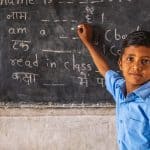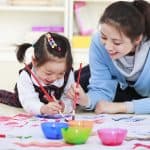
Content > Blogs > Preschoolers > How Learning Second Language Works Wonders for Preschoolers
How Learning Second Language Works Wonders for Preschoolers
- Written By Juliana
- Updated on
Preschoolers rapidly pick second language. They gain confidence and become better communicator by learning second language.

Language empowers us to be social creatures and acquire other social behaviour. It is vital in shaping how we express ourselves, understand others, and connect with people around us.
In Singapore, second language education in primary schools is mandatory. As a country with diverse ethnic groups, understanding a second language helps to maintain cultural identity and encourages harmony among diverse communities.
When preschoolers advance to primary school, they learn a Mother Tongue Language (MTL) as a second language. There are three official mother tongue languages – Chinese, Malay, and Tamil.
Students of Chinese, Malay and Tamil ethnicities will study their MTLs. Students who are Eurasian or of other races and whose mother tongue is not one of the official MTLs, can request to study any of the official MTLs through their schools, subject to approval.
You can visit the MOE website to learn about learning MTLs in schools.
Now that you have comprehended the concept of learning a second language, when should you introduce the foreign language to your child?
A study conducted by Babak Ghasemi found that the best age to start learning a second language is when the child begins learning the first language!
Babies are born with the ability to learn and absorb like a sponge. Therefore, the earlier children become acquainted with a foreign language, the higher the likelihood of achieving proficiency in speaking it.
Let us look at how learning a second language benefits your preschooler and how you can make learning fun.
How learning a second language benefits preschoolers
Learning a second language benefits not only the child’s mental processes but also helps them achieve a successful career in future. Research shows that early exposure to a second language boosts several benefits, such as creativity and problem-solving skills.
Other advantages linked to acquiring a second language education include:
- Increased confidence as the child converses in his second language besides his native language
- Improved memory and listening skills
- A better understanding of grammar and vocabulary
- Making meaningful connections with people in the community
- Exposure to multicultural understanding
Bilingual preschoolers often achieve higher language fluency. As young learners develop cognitive flexibility, they find it easier to do well in reading and writing, even outperforming their monolingual peers. With a strong base of vocabulary and grammar, preschoolers can communicate with others fluently and are more willing to learn other languages in future.
Besides strengthening academic skills, learning a second language helps to foster a profound cultural connection. Preschoolers will develop a deeper understanding and appreciation for diverse cultures and perspectives, developing empathy and global awareness.
Of course, there are drawbacks to learning a second language at a young age, including potential language mixing. This issue can be addressed by differentiating the language and alternating between reading in the native and second languages during storytelling to help preschoolers associate each language with specific parts of the story.
With preschoolers, all activities that have them in giggles and free-play leave a long-lasting memory in them. This is also vital in nurturing a consistent willingness to learn a second language.
Also read : Helping kids become independent learners
Teaching a second language to preschoolers – Fostering a positive learning environment
Cultivating a positive learning environment at home is significant in nurturing and inspiring preschoolers to love a second language.
Here are some ways to help your child enjoy his second language education.
Use the second language at home consistently.
The best thing to do with your preschoolers is to speak the language.
Rotate between speaking the native and second language to help preschoolers differentiate the two languages. Do remember to prioritize their comfort while teaching them the second language. You want to ensure they know it is ok to make mistakes while encouraging them to keep trying.
However, suppose you do not speak the language. In that case, you can use interactive language learning apps, watch age-appropriate TV shows, and listen to songs to engage preschoolers in speaking the second language. The catchy tunes and rhythms help preschoolers remember the sounds of the words better.
Design playful and interactive activities.
Utilize puppets, toys, and props to create dynamic scenarios in the second language, stimulating their imagination and curiosity. Language-themed activities such as scavenger hunts or role-playing cultural celebrations make language learning a fun and exciting adventure.
Make the second language visible in your home.
DIY flashcards in the second language with your preschoolers. Have them as colourful and in all shapes and sizes as you wish. Paste these flashcards on a wall in a particular room. When preschoolers can “see” the second language, it will spark their curiosity
Show enthusiasm and excitement when designing these flashcards. The more fun your preschooler deems the activity, the better they will remember the word and be eager to make more flashcards.
Remember that whatever you do, always praise their efforts for trying. Use positive reinforcement to assure them that mistakes are part of the learning journey.
And to aid in this positive learning journey for preschoolers, there are numerous institutes in Singapore to give them the proper support they need in their second language education.
Centres teaching Second language to preschoolers in Singapore
Chinese Language
Hcl Education Centre
Preschool Programme
Preschoolers will learn through nursery rhymes and fables to improve their vocabulary and expression skills. They will learn to read storybooks in the Chinese language and write simple words to enhance their writing skills.
Malay Language
Future Khulafa
MET Juniors (Ages 4 – 5 years old)
Future Khulafa focuses on preparing preschoolers with the necessary skills and content for their Madrasah Entrance Test (MET). They also provide Arabic classes for students who are taking the language as their MTL.
Tamil Language
Tamilcube Learning Centre
Tamil Speech & Drama (Ages 3 – 8 years old)
Through the Tamilcube GOLDTM Kids program, students are introduced to the Tamil language and culture in a fun-filled environment where they learn through play.
Foreign Language
French Language Academy
Children French Group Classes (Ages 6-10 years old)
Children learn in a fun and interactive environment with stimulating language activities such as role-play and crafts to develop their communication skills.
Hougang Japanese Language School
Kodomo Children Class
Kids learn not only the Japanese language but also Japanese culture, Arts, Music and food.
As-Souq Arabic Centre
Kids Arabic
Expose the little ones to Arabic through fun and creative activities such as catchy Arabic nursery rhymes and tunes. Preschoolers learn to converse in Arabic and be fluent in basic Arabic greetings and daily duahs and surahs.
For the full range of centres offering classes in the second language, click here to browse through them.
In conclusion, learning a second language benefits the child’s cognitive development and boosts their emotional well-being.
Being bilingual gives the child a sense of achievement to become more independent and resourceful problem solvers. As we already know, language is a tool for communication and connection. Conversing competently with people of diverse cultures increases a bilingual child’s confidence growing up.
So, start speaking in the second language with your preschooler today and watch them blossom into a confident and resourceful adult!
Explore Klassbook for more Classes
To explore more classes, go through our list of various preschool classes here. Why not start with a trial class to gauge your child’s interest?

A millennial content writer who is a mom to three growing-up boys and 2 dogs. Like my teenager going through puberty, I am always hungry – for knowledge and food. To replenish my endless need for energy, several cups of coffee a day and snacks are a must-have. Yes, I’m a snack enthusiast – my closest pals will happily vouch that I can’t resist those delectable Kueh Kuehs. When I’m not in writer mode, I’m out training my pup for professional dog agility competitions or embarking on tasty adventures to discover hidden food treasures all over Singapore.
In this Article
Loved Our Articles? Subscribes To Get Updates Directly To Your Inbox!
Related Articles


10 Holiday Camps For Year-End School Holidays In Singapore
October 25, 2023
Learning Hindi language – Hindi Society Singapore and other Hindi Tuition centres
September 7, 2023
Best parent-accompanied classes for preschoolers in Singapore
September 4, 2023
How I Prepared My Highly Sensitive Child for Preschool in Singapore
September 4, 2023
